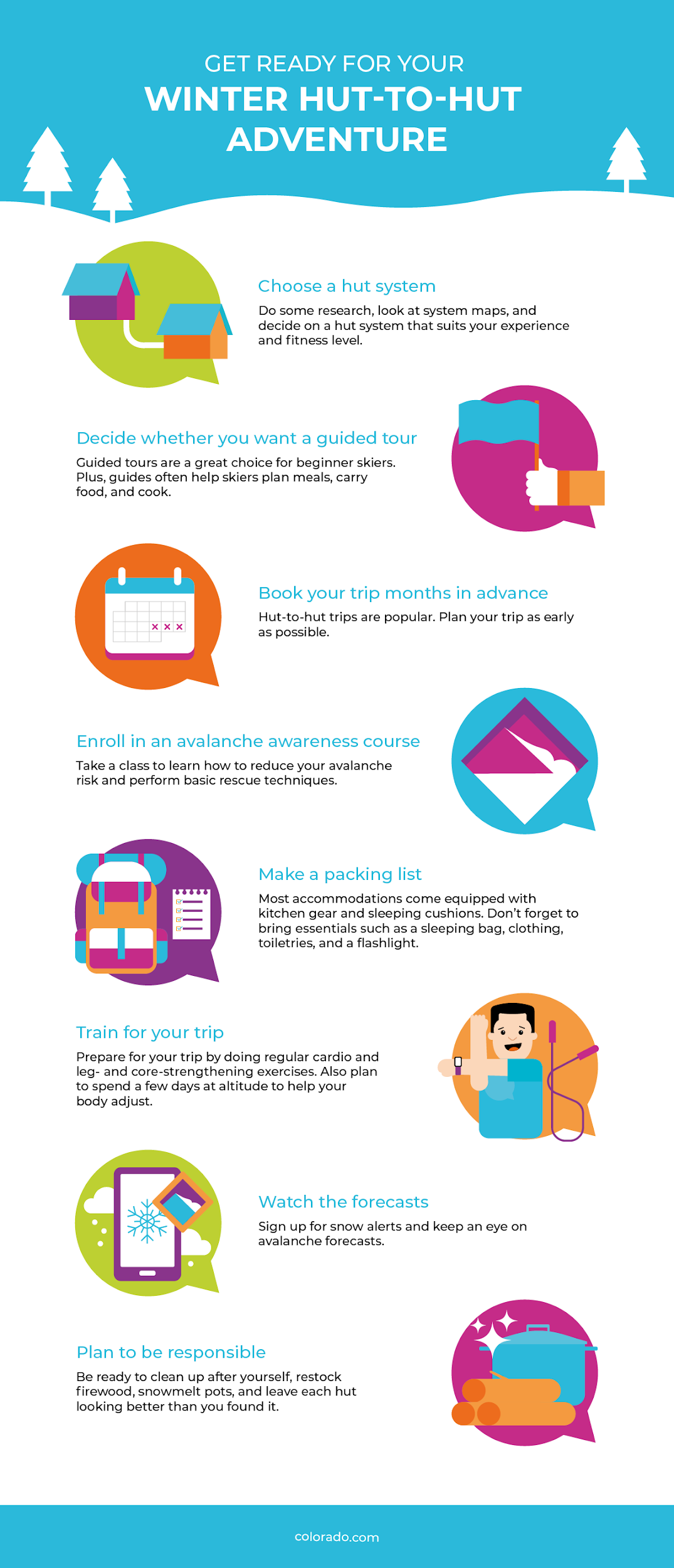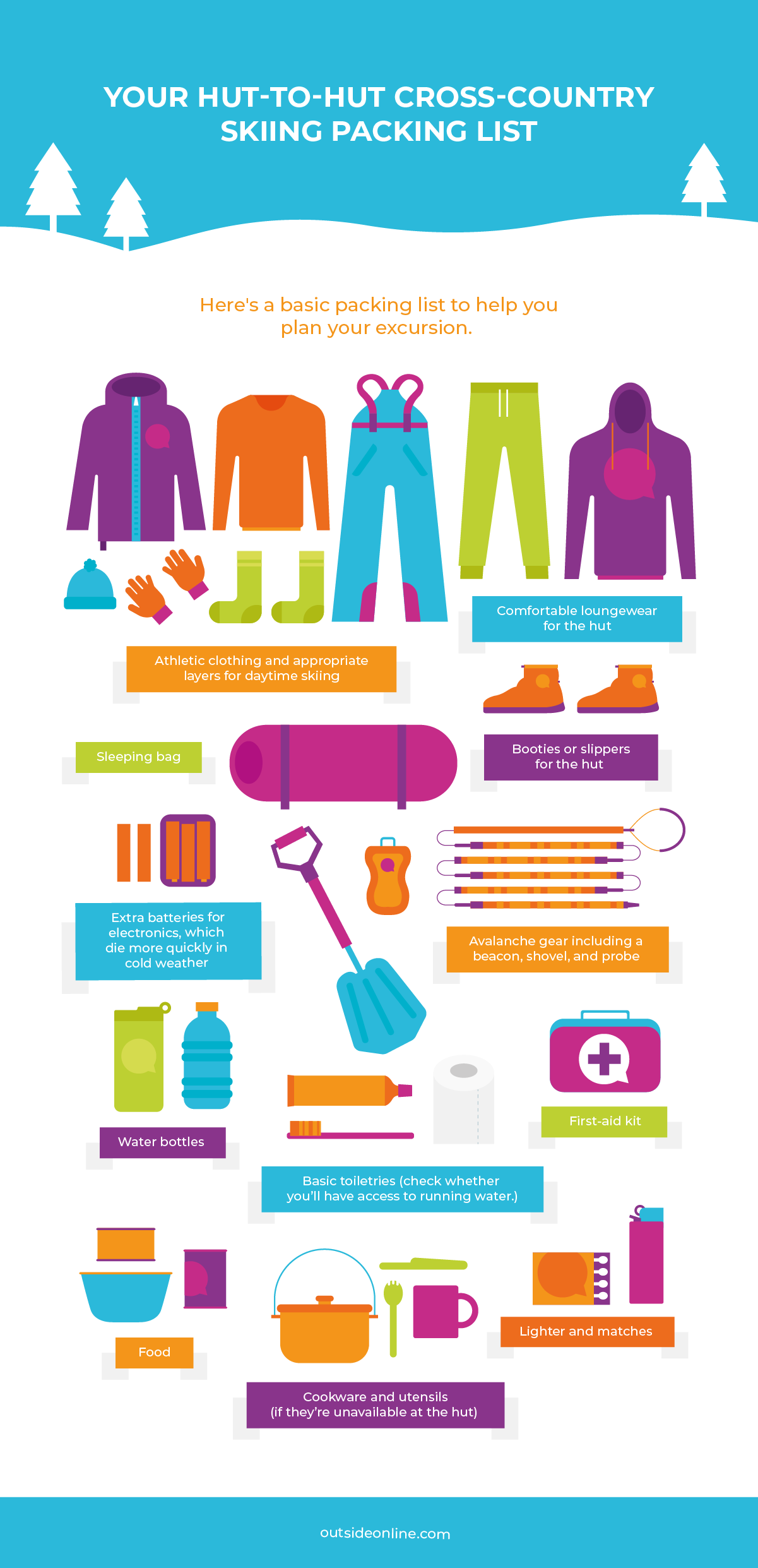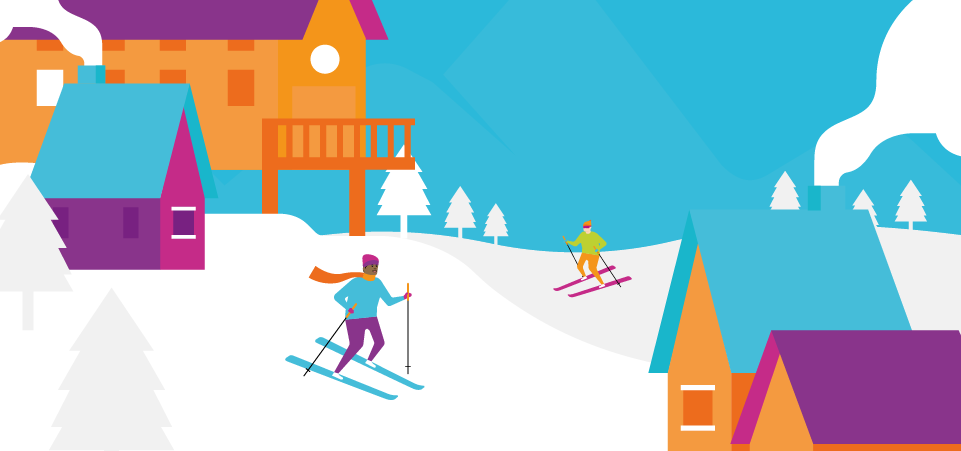Looking for an outdoor winter hobby? Consider cross-country skiing! This beginner-friendly sport immerses you in beautiful settings while you enjoy a low-impact, total-body workout. Plus, once you get your ski legs — or use them if you’re already a pro — you can up the ante with a wintry hut-to-hut excursion via one of the many backcountry hut systems dotted across the U.S. These systems allow you to enjoy multi-day adventures and majestic scenery while snuggling up in warm, cozy accommodations every night.
To get started, you’ll first want to zero in on your hut system of choice. Then, use our guide to plan your first hut trip so you stay safe and comfortable while skiing through gorgeous valleys and mountain backdrops.
The Best Hut Systems in the U.S.
We’ve rounded up seven of the country’s best hut systems.
- Maine Hut and Trails System, Maine
If you’re new to cross-country skiing or backcountry excursions, the Maine Hut and Trails System is a great place to start. This beginner-friendly system is perfect for both cross-country skiers with a range of experience and folks who are more comfortable using snowshoes. You can do a self-guided or professionally guided trip in the well-mapped system. Spend the day Nordic skiing along the system’s 80 miles of trail, then snuggle up in one of four huts complete with heat, power, water, composting toilets, and live-in staff who prepare meals for guests. The Maine Huts & Trails organization plans to add additional huts in the future.
- Rendezvous Huts, Washington
Nestled in Washington’s Methow Valley in the North Cascades is one of the country’s biggest groomed Nordic trail networks, with a whopping 120-plus miles of tracks. Dotted along this system, approximately five miles apart from each other are five basic huts that offer kitchens, cookware, and woodstoves. Skiers are free to ski from one Rendezvous Hut to another or stay for a few nights at one hut and set out on a variety of loop trails from there. (Single-day, three-day, and season passes are available.) Guests should bring their own food, but freight hauling is available for folks who aren’t comfortable trekking with heavy loads. These huts are unique because they allow dogs, so bring Fido and enjoy fun for the whole family.
- San Juan Hut System, Colorado
Located in Southwest Colorado, the Sneffels Range in the San Juan Mountains boasts some of the state’s most stunning and craggiest mountains. You can ski through them—and below 13,000-plus-foot peaks including Last Dollar Mountain, Mears Peak, and Teakettle Mountain—thanks to the San Juan Hut System. It spans 60 miles of Nordic trails and connects five backcountry huts around the towns of Ouray, Ridgway, and Telluride. If you don’t have time to travel to every hut, you can access the 8-person huts individually. The distance between each hut ranges from approximately three to 9.5 miles, so there’s an option for most fitness levels.
- Sun Valley Linkup, Idaho
Take your pick of Idaho’s stunning Smoky Mountains or Sawtooth Mountains and head out on the Sun Valley Linkup, a trek that connects a variety of huts depending on your chosen location and the time of year. In winter, choose from the following huts and yurts.
- Bench Hut, which is located at 7,400 feet on the shoulder of Mount Heyburn in the Sawtooth Mountains
- Boulder Yurts, two yurts with woodstoves and solar power that are accessible to beginners
- Coyote Yurt, which sits at 8,700 feet and appeals to intermediate and advanced skiers and snowboarders who want to enjoy some downhill after making the trek
- Pioneer Yurt, which sits beside an alpine meadow and offers access to advanced ski touring and mountaineering
- Fishhook Hut, which you can access via a gentle approach and features a Mongolian-style yurt and a wall tent connected via a lodgepole-pine framed walkway
- Tornak Hut, which sits at 8,400 feet in the Smoky Mountains and offers access to advanced downhill runs and high touring terrain
Several guide companies offer guided treks, or you may want to consider a self-guided option if you’re already comfortable with backcountry excursions.
- Teton Wilderness Hut to Hut, Wyoming
Teton Wilderness Hut to Hut is the only backcountry hut system in Wyoming, and it’s operated by Teton Backcountry Guides out of Jackson Hole. The system includes four remote wintertime yurts situated in the stunning Tetons. The yurts are rustic: They’re each 20 feet in diameter and you’ll need to do your business in a sheltered latrine. However, the scenery is unparalleled. This system is designed primarily for skiers who want to cross-country ski to a yurt and then enjoy advanced downhill skiing and snowboarding during the rest of their stay. If you’re a beginner, check out the Commissary Ridge Yurt or Plummer Canyon Yurt, which offer more varied terrain for different skill levels.
- Wallowa Alpine Huts, Oregon
Dubbed Oregon’s “Little Switzerland,” the Wallowa Mountains are as jagged and breathtaking as their nickname implies. The Wallowa Alpine Huts system offers incredible opportunities for downhill skiing and snowboarding in wide bowls, old-growth glades, and remarkable couloirs. If you’re new to backcountry excursions, you’ll want to spend the next few years building skills before attempting one of these guided treks. Folks with plenty of backcountry skiing experience can take their pick from four- or five-day trips. After a day of adventure, cozy up in a large yurt or warm up in one of the system’s saunas.
- 10th Mountain Division Hut Association, Colorado
Colorado’s 10th Mountain Division Hut System is named after the 10th Mountain Division of the U.S. Army, which trained at high-altitude Camp Hale (not far from Leadville and Vail) during World War II. The extensive hut system includes 350 miles of trails linking 30 huts around the towns of Aspen, Leadville, and Vail. These hut-to-hut excursions require a high degree of fitness, as you’ll average six to seven miles and gain up to 2,500 feet of elevation between huts. These huts are at high altitude, so it’s important to prepare accordingly. Properly equipped skiers will enjoy majestic scenery and hut accommodations ranging from rustic to relatively lavish.
Tips for Planning Your First Hut Trip
Ready to try a backcountry adventure this winter? Here are some tips to make your first hut trip a success.
- Decide whether you want a guided and catered trip or a rustic adventure
Many hut systems give you the option of traveling with professional guides from a nearby town or going it alone. If you’re new to skiing or backcountry excursions (or both), it’s smart to travel with professionals who can keep you safe. Bonus? Guides often assist with meal planning, food packing, and cooking, so you don’t have to haul a heavy load or work in the kitchen after a long day of skiing. However, there’s something to be said for a more rustic experience in the winter wilderness. Know your limits and choose accordingly.

- Book your trip far in advance
Around the country, hut systems are popular. During the pandemic, interest in huts may be even higher than usual. Thus, you’ll want to book your trip as far in advance as possible — months or even a year. Speaking of the pandemic: Note that hut systems have implemented new policies that make bookings even more scarce. For instance, systems that allowed multiple groups to share a hut are now reserving huts for only one group at a time to limit possible COVID-19 exposure between groups. Research these restrictions and book accordingly.
- Take a course in avalanche awareness and skills
One of the most amazing things about the backcountry is that it’s uncurated, just raw, wild nature at its best. Nevertheless, there’s a downside: Ski patrols don’t perform avalanche mitigation in the backcountry. Avalanches are a major concern whenever you spend time in mountains during the winter, and it’s critical to get proper training before you head into the backcountry. Prior to any hut trip, enroll in a training course to learn how to minimize your risk of ending up in an avalanche and how to perform basic rescue techniques. Check out local avalanche certification programs or look to the American Institute for Avalanche Research and Education. Avalanche training usually costs hundreds of dollars, but it’s a necessary trip expense if you’re traveling without a guide.
- Make a packing list of lightweight essentials
If you’re hauling your own gear, pack as lightly as possible to avoid straining your body more than necessary. Luckily, a hut-to-hut excursion only requires basic necessities.

- Train for your trip
Cross-country skiing is a low-impact activity, but it’s an intense full-body workout that demands a high level of fitness. When you’re in the backcountry, you’ll need the endurance to reach your hut without assistance. It’s important to make sure you’re physically fit prior to a hut-to-hut excursion. Regular cardio and leg- and core-strengthening exercises are a must. Also, if you’ll spend time at a higher altitude than you’re accustomed to, spend a few days at higher altitude prior to your cross-country skiing excursion to help your body adjust.
- Watch the weather forecast
Weather conditions change quickly in the backcountry and at high altitude. It’s important to keep tabs on forecasts so you have some sense of the weather coming your way. Sign up for snow alerts at snow-forecast.com, opensnow.com, or snow-online.com. Also, keep an eye on avalanche forecasts for the area where you’ll be trekking.
- Plan to be a responsible guest
Most hut systems rely on the honor system to keep the huts tidy and clean. Plan to be a respectful guest. Clean up after yourself, restock firewood, refill snowmelt pots, and generally leave each hut or yurt better than you found it.
Conclusion
On a wintertime hut-to-hut excursion, you can immerse yourself in nature while enjoying a full-body workout during the day and comfortable accommodations at night. Book early, train in avalanche safety or enlist a professional guide, pack appropriately, and condition in advance to set yourself up to enjoy an unforgettable adventure.








